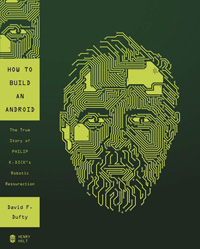The Android Author
David F. Dufty explains how roboticists brought to life an android version of science-fiction writer Phillip K. Dick
Anyone who’s ever left a cell phone or an iPod on an airplane knows the feeling. You pat your pockets, rifle your bag, and panic. Imagine, then, that the missing item isn’t a reasonably inexpensive portable computing device but a one-of-a-kind aesthetic and technological wonder valued at three quarters of a million dollars. Now imagine that this unique computing marvel, apparently lost forever, is in the form of the disembodied head of legendary science-fiction writer, drug addict, and paranoiac Phillip K. Dick, who died in 1982. It may sound like a page from one of Dick’s own novels, but it’s all true, according to David F. Dufty, whose How to Build an Android: The True Story of Phillip K. Dick’s Robotic Resurrection chronicles an attempt to bring the science fiction legend back to life as a robot.
 The Phillip K. Dick android was the work of a group of roboticists, engineers, and artists working out of the University of Memphis. Called the Phillip K. Dick Project, it was a joint venture between the Institute for Intelligent Systems (IIS) and the FedEx Institute of Technology, both of which are housed at U of M. In 2005, while the robot was being assembled, Dufty was a post-doctoral researcher at IIS. He has remained in contact with many of the project’s key players, and it’s their recollections that make up the bulk of How to Build an Android.
The Phillip K. Dick android was the work of a group of roboticists, engineers, and artists working out of the University of Memphis. Called the Phillip K. Dick Project, it was a joint venture between the Institute for Intelligent Systems (IIS) and the FedEx Institute of Technology, both of which are housed at U of M. In 2005, while the robot was being assembled, Dufty was a post-doctoral researcher at IIS. He has remained in contact with many of the project’s key players, and it’s their recollections that make up the bulk of How to Build an Android.
Among the android’s designers were computer programmer Andrew Olney and Dallas-based roboticist David Hanson—Olney was the principal designer behind the android’s brain, and Hanson, a sculptor, was responsible for the robot’s lifelike appearance. It was Hanson who, in December of 2005, inexplicably left the Dick android’s head on an America West flight between Dallas and Las Vegas. The real Phillip K. Dick was an impressive yet quirky guy. Addled by drug abuse, he nonetheless managed to crank out book after book—often working amidst a house full of runaways, hangers-on, speed-freaks, and fellow misfits. Though contemporary reviews were mixed, many of Dick’s stories are considered science-fiction classics. Eight have been made into films, including Do Androids Dream of Electric Sheep? and A Scanner Darkly. The former became the future-noir classic Bladerunner (1982); the latter, a computer-animated waste of time starring Keanu Reeves (2006).
At the height of its powers, the Phillip K. Dick android was also impressive. His Artificial Intelligence was loaded with practically every word Dick wrote, along with his responses to countless interview questions. With face and voice recognition, the android was able to converse on an almost infinite number of topics, turning its motorized head and neck to face its questioners. It had a camera for eyes and a speaker for a mouth. Beneath its lifelike skin—made of a synthetic material called Frubber—were dozens of servos, motors, and cables designed to replicate the complex musculature of the human face. For display, Dick’s body, though immobile, was perched on a period couch in a replica of his living room circa 1974.
Like its inspiration, the Dick android also had its quirks. Some of How to Build an Android’s most entertaining moments chronicle the way the robot’s responses eerily mimicked Dick’s well known eccentric tone. When asked where he is, for example, the android surveyed his room and came up with, “We appear to be in my living room. (Pause.) It could be a simulacrum, though (pause), but why would the authorities bother?”
The Phillip K. Dick android debuted in Chicago at NextFest 2005, a festival of innovative products sponsored by Wired magazine. With Olney and Hanson in attendance, the sophisticated robot was the hit of the event, but it wasn’t just about the science. Here Dufty paraphrases Hanson: “A visionary genius from a century ago conjoined with a physical demonstration of the frontier of human accomplishment today. Now that’s a comment on the state of society and emerging technology…. That’s art.”
 Journalists clamored for interviews, and Hanson and Olney become instant rock stars in the technology world. After this initial splash—or perhaps because of it—the designers were increasingly distracted by other projects: Olney took on an administrative role with the FedEx Institute, while Hanson began work on “Albert Hugo,” an android version of Albert Einstein. As a result, the Dick android’s follow-up appearances were hastily planned and less impressive than its debut; the android had some meltdowns, and support for the project began to wane.
Journalists clamored for interviews, and Hanson and Olney become instant rock stars in the technology world. After this initial splash—or perhaps because of it—the designers were increasingly distracted by other projects: Olney took on an administrative role with the FedEx Institute, while Hanson began work on “Albert Hugo,” an android version of Albert Einstein. As a result, the Dick android’s follow-up appearances were hastily planned and less impressive than its debut; the android had some meltdowns, and support for the project began to wane.
As a favor to a colleague, however, a frazzled Hanson agreed to squeeze in one additional appearance for the android Phillip K. Dick. It was to be held at the Googleplex, the headquarters of technology giant Google in Mountain View, California. The Google event might have reinvigorated the project had not Hanson accidentally left his charge—stored in a carryon bag—in an airplane’s overhead bin along the way. The Google event was scrapped, and the Phillip K. Dick android was consigned to legend. The word “legend” is appropriate here, as one can imagine the sorts of wild conspiracy theories that fans of the famously paranoid writer came up with once word of the missing head—which has never been found—got out.
Though Dufty was not present during many of the events depicted in How to Build an Android, he nonetheless employs the omniscient narrative voice. For the layman, this makes for seamless, entertaining reading, though pure-science types may be put off by the more reader-centered approach. How to Build an Android is a good yarn, though, and Dufty’s account—particularly of the race to complete the robot in time for NextFest—is captivating. Much of How to Build an Android hinges on the relationship between Olney and Hanson, who are polar opposites. Olney, a programmer, is methodical and analytical, while Hanson, a sculptor, takes a more serendipitous approach. It figures that, of the two, it’s Hanson, the artist, who leaves the android’s head on the plane.
The pair’s relationship also illustrates a rift in the robotics community between robots that are lifelike and those that aren’t—a theme that can be found in Dick’s own writings. The majority of roboticists maintain that lifelike androids are, first and foremost, creepy. Humans, they say, have a better time relating to robots that are machinelike. Other roboticists, like Hanson, believe that aesthetics count and that humans relate best to robots that look like them.
This argument gets to the point of how humans create meaning—a topic that Dufty barely has room to touch on in How to Build an Android. The author makes it obvious, however, that, robotic technology is proceeding at a breakneck pace, and the stakes are high. As humans attribute more and more humanness to nonhuman entities, they risk going down the dangerous road that Dick himself traveled: “Phillip K. Dick made the same error, peering too deeply into his own art, finding messages to himself from himself about himself,” Dufty concludes. “Like the android, he malfunctioned, but for very different reasons.”


